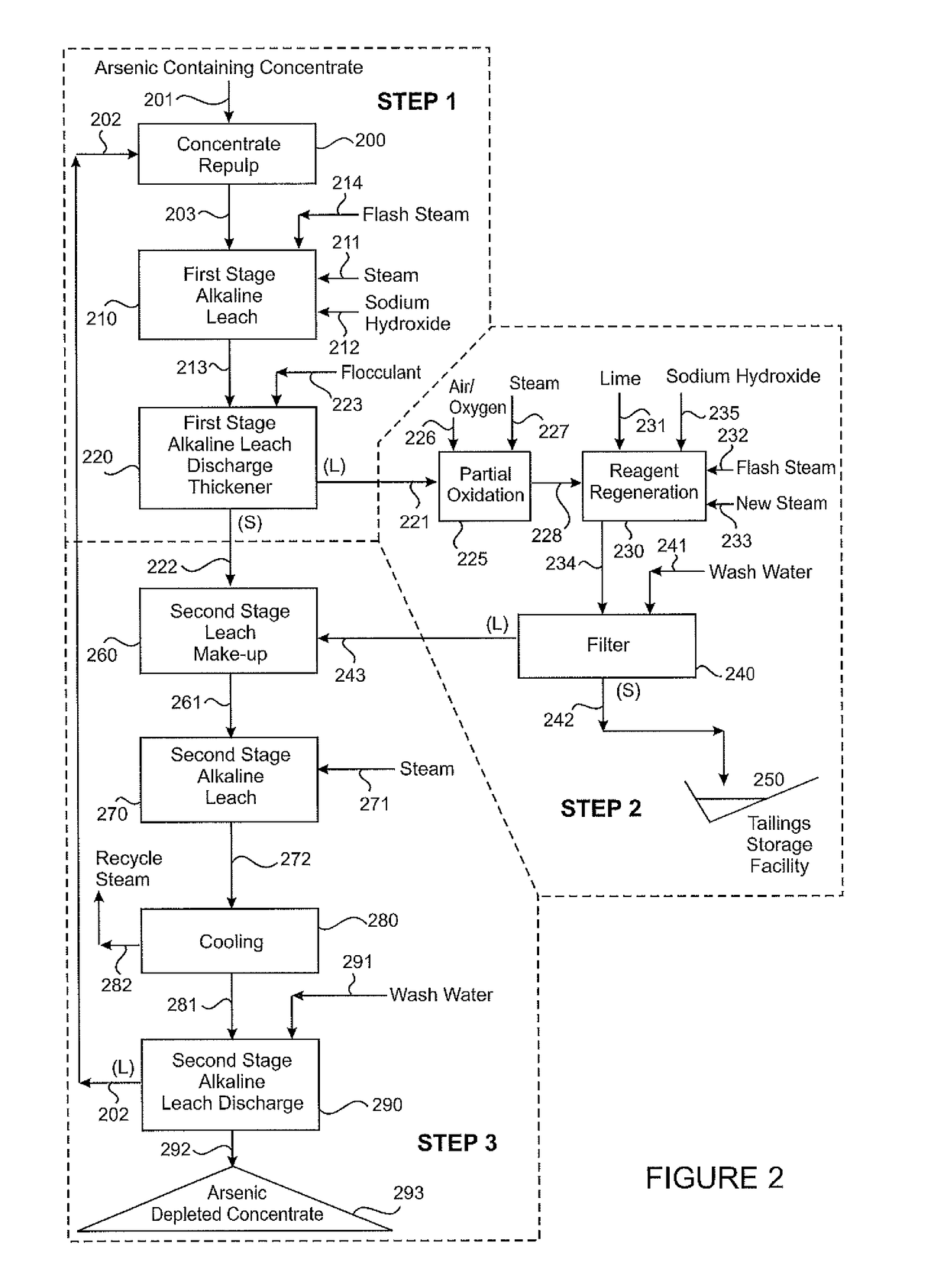Purification of copper concentrate by removal of arsenic and antimony with concomitant regeneration and recycle of lixiviant
- Summary
- Abstract
- Description
- Claims
- Application Information
AI Technical Summary
Benefits of technology
Problems solved by technology
Method used
Image
Examples
example 1
[0092]A South American arsenic and antimony containing concentrate was processed according to Step 1. The concentrate grade is given below:
%Cu45.6Fe12.8S31.4As4.1Sb0.29
[0093]The sodium hydroxide concentration in the Leach step was 96 g / L. The operating temperature of the Leach reactor was 180° C. The concentration of arsenic and antimony in the Leach residue was:
After 1 hour %After 2 hours %As0.240.12Sb0.090.08
[0094]The composition of the Leachate after 1 hour was:
g / LAs14.1Sb0.79Na52
[0095]The Step 1 Leachate was treated with lime slurry at 100° C. and the composition of the Step 2 regenerated liquor was:
After 1 hourAfter 4 hoursg / Lg / LAs2.71.4Sb0.480.08Ca0.010.01
[0096]The lime dose was 45 kg / tonne of dirty concentrate feed to Step 1.
[0097]The arsenic and sulfur composition of the Step 2 residue was:
%As26S0.33
example 2
[0098]A South American arsenic and antimony containing concentrate was processed according to Step 1. The concentrate grade analysis was:
%Cu26.4Fe25S32.9Si2.3As1.82Sb0.094Al1.08
[0099]The regenerated Feed liquor analysis after recycle from a previous flow-sheet cycle was:
g / LNa119As1.22Sb0.14Al0.10Ca0.275Si0.3
[0100]This liquor was blended with the incoming concentrate and diluted to a sodium hydroxide liquor of 120 g / L.
[0101]The Leach was conducted at 200° C. under anaerobic conditions with a solid density of 30%
After 10After 20After 30minutesminutesminutesCu%26.926.526.0S%32.030.731.0Si%2.102.101.7As%0.200.140.12Sb%0.0250.0260.021
[0102]The Leachate values were:
After 10After 20minutesminutesAsg / L10.110.4Sbg / L0.370.38
[0103]The Leachate was split into two fractions and the first fraction was treated with: oxygen gas at 95° C. and 1000 kPa(g) in an equivalent of a pipe line reactor for 10 minutes, and then treated with lime slurry to precipitate the arsenic and antimony.
[0104]The above t...
example 3
[0139]The Chilean concentrate employed in this test was the same as that in Example 1:
%Cu45.6Fe12.8S31.4As4.1Sb0.29
[0140]The concentrate was repulped at 30% solids in a Second Stage Alkaline Leach liquor (stream [202]) and subjected to a First Stage Alkaline Leach (step [210]) at just over 100° C. for 3 hours. The composition of the leachate [221] from this step was:
g / LAs19Sb1.1
[0141]This leachate [221] was treated in the Reagent Regeneration Step [230] employing lime (but no sodium carbonate).
[0142]The Reagent Regeneration Step employed a specific lime dose of 14 kg CaO equivalent per cubic metre of feed liquor and an operating temperature of 100° C.
[0143]The composition of the regenerated liquor [243] before evaporative concentration was:
g / LAs1.76Sb0.41Na30.1
[0144]This liquor was boiled down to produce a lixiviant concentration of 50 g / L Na at which point it was blended with the partially leached concentrate [222] from the First Stage Alkaline Leach [210] and subjected to a Second...
PUM
| Property | Measurement | Unit |
|---|---|---|
| Temperature | aaaaa | aaaaa |
| Temperature | aaaaa | aaaaa |
| Temperature | aaaaa | aaaaa |
Abstract
Description
Claims
Application Information
 Login to View More
Login to View More - R&D
- Intellectual Property
- Life Sciences
- Materials
- Tech Scout
- Unparalleled Data Quality
- Higher Quality Content
- 60% Fewer Hallucinations
Browse by: Latest US Patents, China's latest patents, Technical Efficacy Thesaurus, Application Domain, Technology Topic, Popular Technical Reports.
© 2025 PatSnap. All rights reserved.Legal|Privacy policy|Modern Slavery Act Transparency Statement|Sitemap|About US| Contact US: help@patsnap.com


